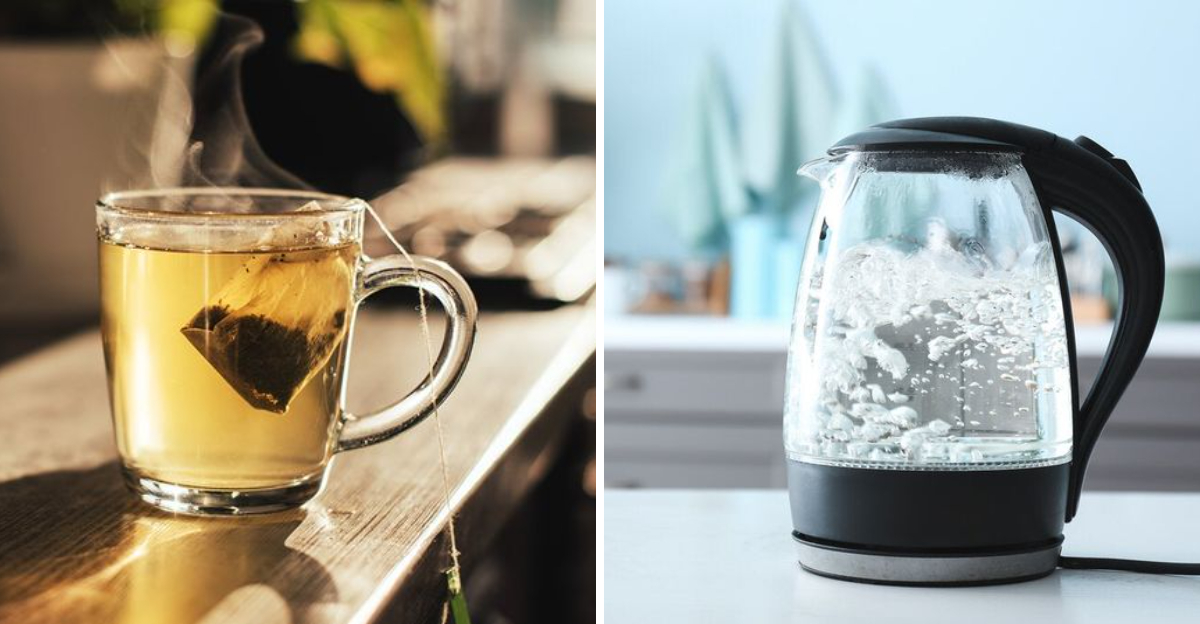13 Common Brewing Habits That Can Affect Tea Flavor

Making a perfect cup of tea seems simple, but small details can dramatically change the flavor.
Whether you’re a casual sipper or tea enthusiast, certain brewing habits might be sabotaging your cuppa without you realizing it. Let’s explore thirteen common practices that influence how your tea actually tastes in the cup.
1. Using Water That’s Been Re-boiled
Fresh water contains dissolved oxygen that helps tea flavors bloom properly.
When you repeatedly boil the same water, oxygen levels plummet, resulting in a flat-tasting brew lacking vibrancy. The minerals in water also become more concentrated with each boil, potentially giving your tea an unpleasant metallic undertone.
2. Incorrect Water Temperature
The thermometer doesn’t lie, different teas need specific temperatures to shine. Green and white teas scorch at boiling temperatures, releasing bitter compounds that overwhelm their delicate notes.
Meanwhile, black teas and herbals need that near-boiling heat to extract their full-bodied character and rich flavors.
3. Steep Time Troubles
The ticking clock makes all the difference! Leave those leaves lounging too long, and tannins take over, creating that mouth-puckering astringency nobody enjoys.
Rush the process with too brief a bath, and you’ll miss the symphony of flavors waiting to be released. Think of steeping as a Goldilocks situation, finding that ‘just right’ moment.
4. Tea Quantity Confusion
Skimping on leaves creates a disappointing, watery experience lacking character and depth.
A proper measure ensures all the intended flavor notes can express themselves fully. Conversely, cramming too much tea into your infuser transforms a potentially pleasant cup into an intensely bitter, overpowering brew. Balance is key to unlocking tea’s true character.
5. Cold Teapot Syndrome
Pouring hot water into a chilly teapot creates an immediate temperature drop that can sabotage your brewing before it begins. This sudden cooling prevents proper extraction of flavors and aromatic compounds.
A simple pre-warming ritual, swirling hot water in your pot before the actual brew – maintains the ideal temperature throughout steeping for consistent results.
6. Ignoring the Golden Ratio
Tea brewing is secretly a math equation! Too much water drowns the leaves’ potential, while too little creates an overwhelming intensity that masks nuanced flavors.
The classic 2-3 grams per 8 ounces serves as a reliable starting point. From there, you can fine-tune based on your preference for stronger or milder brews without sacrificing quality.
7. Water Quality Neglect
Your tea is mostly water, so that municipal tap supply loaded with chlorine and minerals might be the culprit behind off-flavors.
Hard water creates scummy films while soft water produces flat cups. Quality filtered water provides a neutral canvas that allows tea’s true character to shine without chemical interference or mineral distractions.
8. Free-Floating Tea Leaves
Loose leaves need room to dance! When confined to tiny infusers or left swimming freely in your cup, they can’t expand properly to release their full flavor potential.
Additionally, those free-swimming leaves continue steeping indefinitely, turning your last sips bitter and harsh. A properly sized infuser gives leaves expansion space while maintaining brewing control.
9. Timing Negligence
Each tea variety has its own personality and preferred steeping duration.
Delicate greens can turn bitter after just 2 minutes, while robust pu-erhs might need 5+ minutes to fully express themselves. Following recommended steep times isn’t just following rules, it’s respecting the tea’s natural chemistry and ensuring you experience what the tea maker intended.
10. Multiple Infusion Missteps
Many quality teas, especially oolongs and pu-erhs, are designed for multiple steepings, each revealing different flavor dimensions. The common mistake?
Using identical steep times for every round. Each subsequent infusion generally needs additional time as the leaves gradually surrender their flavor compounds. Adjusting steep times ensures each cup remains flavorful rather than progressively weaker.
11. Premature Additions
Patience pays off when it comes to doctoring your brew! Adding milk while the tea is still steeping can halt the extraction process and create uneven flavor development.
Lemon’s acidity can curdle milk proteins and interfere with tannin extraction. Let your tea fully develop its character before introducing any additions for a more balanced, harmonious final cup.
12. Lidless Brewing
Missing teapot lid lets your tea’s aromatic compounds escape. Essential oils and volatile flavor elements drift away with the rising steam when left uncovered during steeping.
Temperature stability also suffers, as heat escapes quickly from an uncovered vessel. Simply covering the teapot traps these elements, allowing them to be reabsorbed into the brew for a fuller flavor.
13. Delayed Drinking
A freshly brewed cup reaches its flavor peak moments after proper steeping. The longer tea sits, the more its volatile aromatics dissipate into the air instead of your palate.
Extended sitting also allows oxidation to continue, gradually flattening brightness and introducing unwanted bitterness. For true tea enlightenment, timing your sips is just as crucial as timing your steepness!
